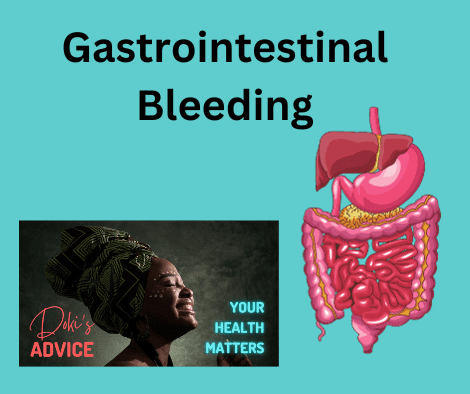Lower and upper gastrointestinal bleeding

Upper gastrointestinal Bleeding (GI-Bleeding)
-This is bleeding that occurs in the upper gut, stomach and/ or the duodenum (this is the first part of the small intestine).
-What do you have to look out for if you suspect that you are having upper GI-bleeding?
Here are some signs:
- Most obvious one is if you vomit blood: this can be red or dark brown resembling the colour of coffee.
- Black, tarry stool: now here we must caution, because someone taking iron medication or medication containing iron tend to also have black stool. For such people this wouldn’t be a sign of bleeding.
- Dizziness and/ or Fainting: this is due to loss of blood.
- Weakness and getting tired too quickly: also due to blood loss.
- Heartburn: now warning this is a very general symptom that occurs to many of us. That means this alone doesn’t ascertain that one has an upper GI-Bleeding.
- Nausea: also, a very general symptom, but mostly occurs in combination with vomiting blood.
- Symptoms of shock
-What should we understand by this? This is when one loses a large amount of blood that the body suddenly goes into a shock mode:
-What to look out for when in shock?
- Sudden drop of blood pressure
- A very fast pulse rate
- Not urinating at all or very minimal amount of urine in the cause of the day: this is caused by reduced amount of blood flowing to the kidneys, hence causing an acute kidney failure.
- Unconsciousness
-If this happens seek medical attention ASAP!
-Now that we know what signs to look out for, lets dive into the various causes of upper GI-Bleeding.
- Peptic ulcers ̴40%: this are sores on the deeper lining of the intestinal tract. These sores can occur in any part of the intestine. When the deeper lining is destructed by too much stomach acidity or infections or medication, it can be so severe to the point of damaging blood vessels running underneath the intestinal lining hence causing GI-Bleeding.
- Causes: H-pylori infections, anti-inflammatory drugs (Ibuprofen)
- Gastric erosions ̴20%: this are sore on the upper lining of the stomach. This can occur due to alcoholism, frequent us of medication such as ibuprofen,
-Signs of gastric Ulcers: heartburn, indigestion, or reflux.
- Varices bleeding ̴15%: these are swollen or large blood vessels that develop in the gut and the stomach mostly due to a chronic liver disease such as Liver cirrhosis. They develop when the normal blood flow to the liver is blocked either due to scaring or a blood clot, hence causing blood to flow in smaller blood vessels, that in normal circumstances, can only transport blood in small amounts. When the blood in these vessels increases, there stands a risk of them busting open, hence upper GI-Bleeding.
-Stomach acidity can increase due to factors such as: bacterial infections or medication like Ibuprofen taken for a longer period without taking PPI’s (PPI are drugs meant to reduce the acidity produced by special stomach cells).
- Gut and stomach tumours: When the stomach lining is weakened or a penetration of the tumour through a blood vessel.
- Mallory Weiss tear: This is a tear that occurs along the gut due to prolonged vomiting or coughing. The Lesions caused can bleed so much that an intervention would be necessary to prevent excessive blood loss.
Prevention and Treatment of upper GI-Bleeding
Avoiding excessive consumption of alcohol
Avoid excessive smoking.
Early and thorough treatment of bacterial infections caused by H-Pylori
By prolonged use of anti-inflammatory drugs supplementary use of PPI’s (These are medication to help reduce stomach acidity).
In cases of bleeding, seeking immediate medical attention with interventions such es endoscopic haemostasis
Lower Gastrointestinal Bleeding (GI-Bleeding)
Now let’s jump into the lower part of the GI-Tract and look at the signs and symptoms, evaluate causes, and look at the interventions.
Lower GI-Bleeding is occurring in the lower gut. Lower gut is considered to start from lower small intestine and the whole large intestine till the rectum.
Let’s have a look at some signs and symptoms:
General symptoms:
- Pale Skin due to blood loss
- Feeling weak or getting tired quicker than normal, even after doing work that requires less amount of energy.
- Heart palpitations
- Fainting
- Dizziness
Specific Symptoms for lower GI-Bleeding:
- Red blood mixed with stool or layering on stool.
- Uncommon: black stool when the bleeding is located at the lower small intestine (medical term Ileum or caecum).
- Increased stool frequency: blood sometimes acts as a laxative in the lower GI-tract.
Now that we know what to look out for let’s see what causes bleeding of the lower GI-Tract
- Haemorrhoids: these can be large or small lumps of blood vessels located on one’s rectum that tend to cause bleeding especially due to hard stool like during obstipation. Many people suffer from this, so there’s no need to feel ashamed. Signs are:
- Bright red blood layered on stool.
- Itchy anus
- Feeling pressed even after defaecation
- Mixture of mucus and blood on the toilet paper after wiping your bottom
- Lump around the anus or on the end parts of the rectum.
- Pain after defaecation
- Angiodysplasia: these are abnormal blood vessels that can form in any part of the GI-Tract. This means they can cause an upper or a lower GI-Bleeding depending on where they located.
- Rectal varices: these are collateral blood vessel formed on the lower GI-Tract due to hypertension caused by Liver cirrhosis. Now would you like to know what Liver cirrhosis is? Then please read our previous articles to get more informed.
- Ischaemic colitis: this occurs when blood flow to a certain part of the large intestine is temporarily reduced by narrowing of the blood vessels supplying blood to that part of the intestine. Meaning limited oxygen to the digestive cells, hence limiting its functions. Theis can be caused by low blood pressure. Signs are:
- Pain like cramping of the stomach. This can be a sudden pain which comes and goes.
- Bright red blood in your stool or passing blood without stool.
- Nausea and diarrhoea
- Colorectal Cancer: Now this is a topic on its’ own but just to highlight some of its common signs:
- Change in stool: that means there are time one has diarrhoea and other times one is obstipated. This occurs especially when the tumours are so big that they are covering a large part of the intestinal lumen.
- Bleeding
- Anaemia
- Colon polyps: these are small clumps of tissue cells that form on the intestinal lining. Most of them are benign. Meaning that they are harmless. BUT over time some of the polyps can change their genetic code to malign tissue, meaning they become cancerous. Most Polyps don’t cause any symptoms as they are harmless, up until they start bleeding, or they become so big that they also occupy a large space of the intestinal lumen causing a change of bowel habits (diarrhoea to obstipation).
- Diverticulosis/Diverticulitis: these are small bulges on the lining of the intestine, where stool can get stuck. The pouches formed by the bulging can be inflamed and cause infections. They are mostly found on the lower left of the large intestine; hence most symptoms of abdominal pain are also located there. Signs are:
- Lower left abdominal pain
- Nausea and vomiting
- Fever
- Constipation
- Bleeding
- Chronic inflammatory bowel disease (CIBD): Now these is a term for 2 very large diseases which we will discuss in a whole segment of its own. But to bring some perspective into this term, it stands for 2 conditions: Crohn’s disease and ulcerative colitis.
- Crohn’s disease: is an CIBD characterised by inflammation of the both the large and/or small intestines. The inflammation can start at any part of the intestine and mostly starts at between the age of 15 to 35 years.
- Ulcerative colitis: is a CIBD characterised by inflammation that mostly starts in the lower part of the large intestines then spreads upwards. Of course, there exists some abnormalities where the inflammation starts at the last part of the small intestines.
- The most common symptoms for both are: frequent diarrhoea (up to 10 to 15 times a day, rectal bleeding, abdominal pains, and weight loss
Whoo! Now that we know all these causes let’s have a look at what interventions we have:
- Doing an emergency endoscopy when one has relevant blood loss, or general endoscopy (here we have colonoscopy or proctoscopy, depending on which one is needed).
- By heavier blood losses that can’t be stilled using endoscopic measures then the solution is surgery.
- For Colorectal cancer, Diverticulitis and CIBD depending on how the therapy regimes are your doctor should advice on the method of intervention.
How do you prevent all these you may ask? Now here it gets a little bit tricky because some of these could be genetically caused like colorectal cancer or CIBD. Despite all that, here are some things one could do:
- Eat food rich in fibres, the helps keep stool soft, hence reducing haemorrhoidal bleeds, and diverticulitis. BUT during an acute diverticulitis infection one should avoid foods rich in fibres for at least one month or at least until the infection is over.
- Avoid chronic consumption of alcohol to avoid liver cirrhosis, hence avoiding rectal varices.
- Avoid smoking since chain smokers for years have a higher risk of getting ulcerative colitis.
- Proper management of high blood pressure, exercising regularly.
Diet for GI-Bleeding
Understanding the cause of the diagnosis is always necessary to adapt nutrition in patients with gastrointestinal bleeding.
Generally, foods rich in iron are recommended as one can lose a lot of iron during bleeding especially if it is extensive. It is also advised to eat small meals more often while your digestive system heals. Some lifestyle adjustments are also necessary, that is restricting alcoholic drinks, smoking, caffeine (coffee, regular tea, chocolate), mints (peppermint and spearmint), garlic, onions, fried, greasy, or spicy foods, high acid foods such as citrus fruits and juices, bubbly drinks, tomato products if one engages in them. Alcohol and smoking should be avoided as they increase stomach acids and lead to ulcers which worsen the bleeding. The general idea with food is to avoid foods that cause either heartburn, nausea, or diarrhoea.
Examples of recommended foods are red meat, shellfish, poultry, eggs, beans, raisins, whole-grain breads, and leafy greens.
For more informative Reads…. keep it Doki’s Advice.

